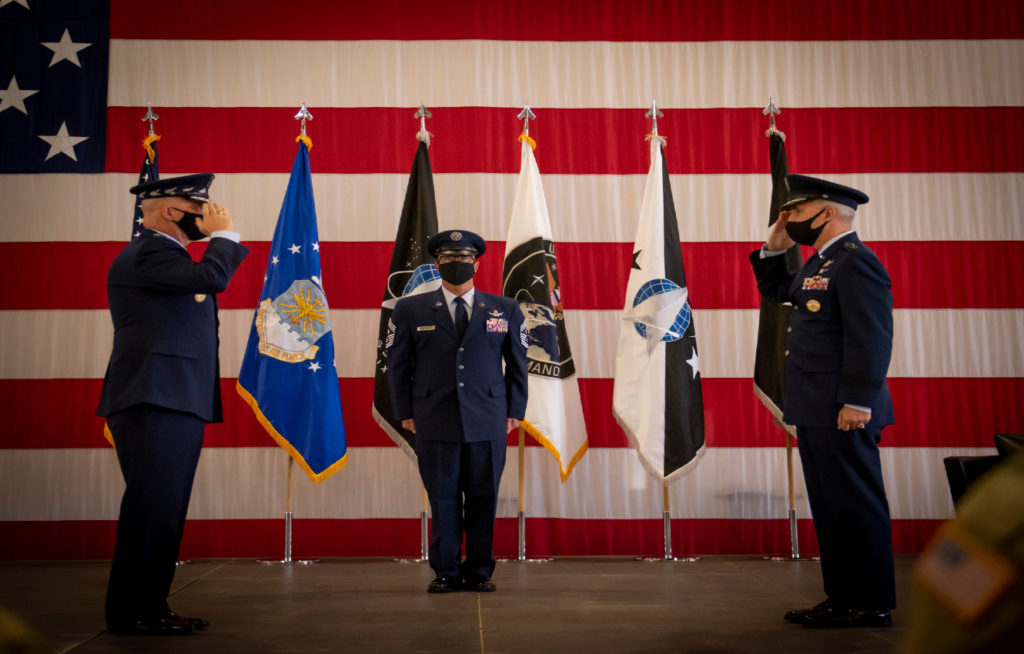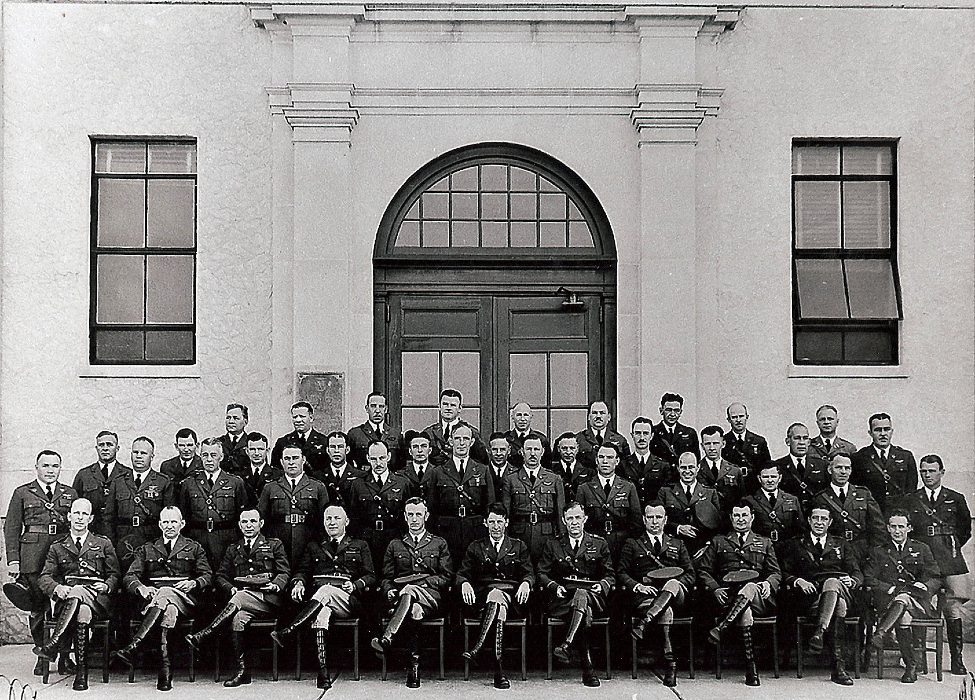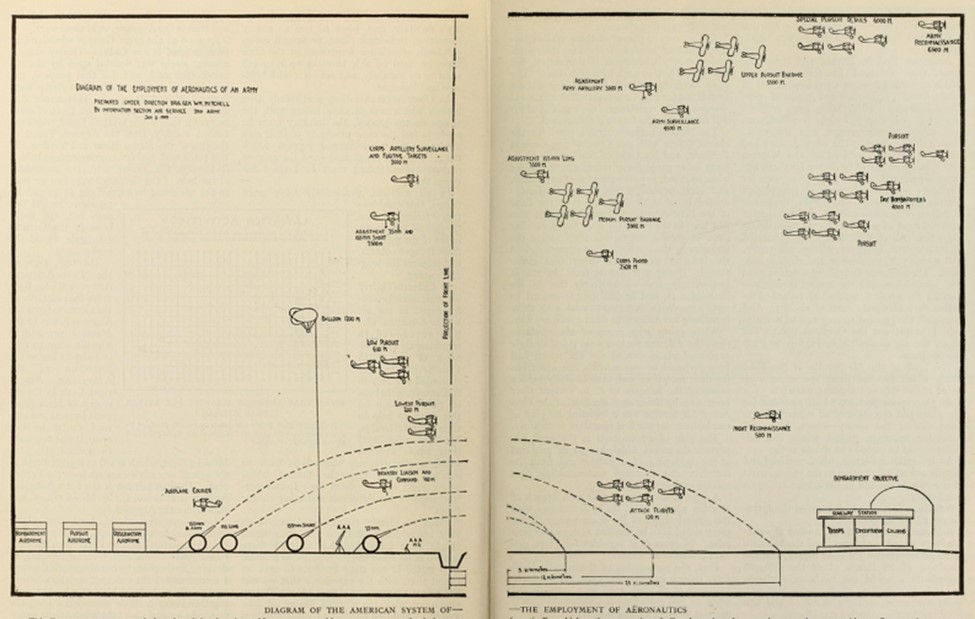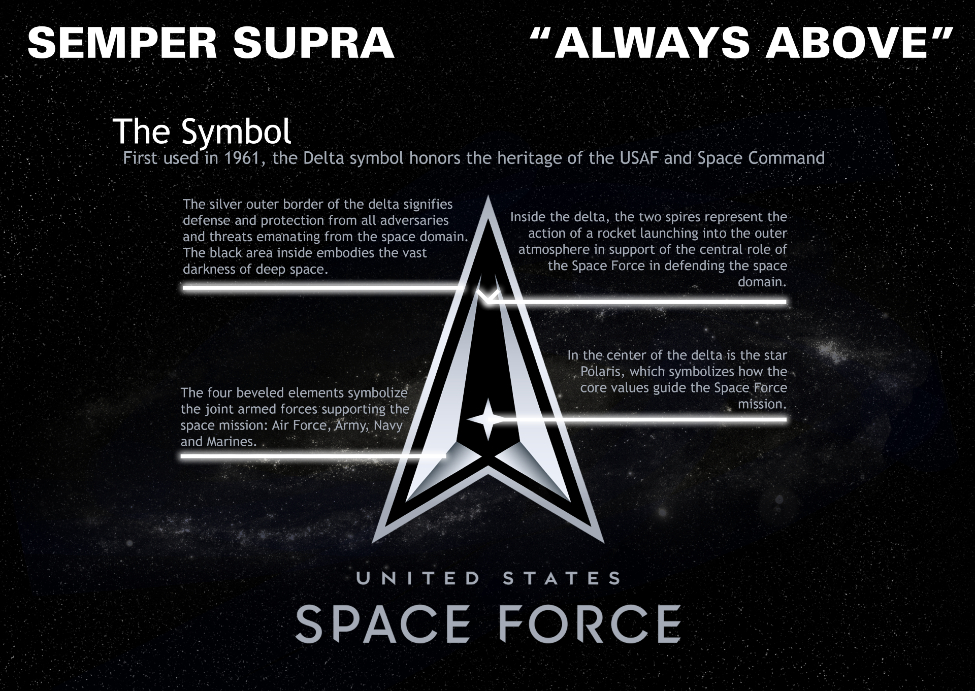You Can’t Escape Your Past … Even in Space: What Space Force Can Learn From the Air Corps Tactical School

“If we get this right, we will be the envy of the other services because we are not tied to the past.” This statement from Gen. Jay Raymond, the Space Force’s chief of space operations, was referring to how the service intended to establish a new culture unhindered by the legacy of its origins within the Air Force. It’s understandable why the Space Force would want to do this. After all, new institutions often seek to reinforce their independence and unique identity.
However, such an ambition is unlikely to succeed completely. First, culture is a powerful force that is virtually impossible to discard, no matter how earnestly desired. It can be difficult to break free from past institutional associations. As Bleddyn Bowen notes, the Air Force’s “embedded cultural writing remain[ed] largely intact” after independence from the Army in 1947. This tendency can be seen in a recent ceremony for the Space Force’s first enlistees, in which Gen. David Thompson jokingly told the audience that it was “pretty much the same” as the Air Force “but cooler.” Second, and more concerning, the Space Force’s future cultural development will be torn between two paths. One path centers on the quiet example of the space professionals who have spent their careers earnestly providing support for the other services. The other draws on the more outspoken but equally earnest advocates of “independent” options, as Raymond recently mentioned.
The most important cultural challenge the future Space Force faces, then, is not about choosing the right symbols and ranks, which has been the subject of recent heated debate. One advocate, for example, has recently characterized the adoption of naval rank for the Space Force’s “officers” as the “most important and far-reaching decision in the Fiscal Year 2021 National Defense Authorization Act.” Instead of focusing on symbols, the Space Force should provide a long-term and transparent strategy that illuminates how it will balance traditional missions supporting warfighting on Earth versus more forward-thinking ones that may not be practical in the short- or even mid-term.
Space Force should look to the past for guidance on how to navigate the competing demands of tradition and independence. Specifically, it should examine key lessons of what the Air Corps Tactical School — an institution that the Army established to promulgate air support lessons learned from World War I — did to help create a new cadre of Air Force officers. It also should take steps to avoid following the school’s greatest misstep: veering too far off course to pursue independent options.
The Birth of the Air Corps Tactical School and Strategic Bombardment Culture
The Army established the Air Corps Tactical School in 1920 at Langley Field, Virginia — later moving to Maxwell Field, Alabama, in 1931 — to train airmen to provide better ground support to the Army. Instead, it became the seedbed for developing strategic bombardment doctrine and the intellectual training of officers in the Army Air Corps. The school played a large role in creating the Air Corps’ culture, which above all sought independence from the Army, placing far more emphasis on developing capabilities to win wars by destroying key nodes of an enemy’s economy than improving air-ground support. Scholars like Craig Cameron argue that culture cannot be neatly separated out from everything an institution does. In other words, culture is more than heritage and other symbols that foster group identity. Instead, it is daily patterns of thought that shape an institution’s vision for how to employ force, which are its most deeply held assumptions. Whereas the Army wanted to use airpower to improve combined arms, airmen hoped to win wars more quickly and efficiently, ideally avoiding the ugly battlefield attrition that characterized the Western Front during World War I. This set a precedent for continuing tension between soldiers and airmen that has never entirely gone away.
Figure 1: Air Corps Tactical School  Source: U.S. Air Force
Source: U.S. Air Force
Continuity in Air Corps Tactical School Thinking
The Air Corps Tactical School operated with some connection to its Army roots for much of the interwar period. As Lori Henning stresses, for example, it continued to teach subjects like cavalry as late as 1939 to help refine understanding of when cavalry should be employed for reconnaissance and when airpower should be used. Likewise, Space Force officers still receive much of their professional military education at Air University, where airmen once attended the Air Corps Tactical School. The balance between joint education and education focused on space should be maintained over time. As Maj. Ira Eaker wrote in his course critique of the Air Corps Tactical School in 1936:
During the first half of the school year the student gets the impression that he is attending a service school of one of the other arms. … During this time he is turned over to the tender mercies of Field Artillery, Cavalry, Infantry, and Chemical Warfare. … After Christmas vacation, the student begins to find that this is, after all, an Air school. Bombardment, Attack, Observation, Pursuit and Air Force are then thrown at the student with bewildering rapidity.
Eaker thus spent half his time learning about the Army and the other about the Air Corps.
Had he not studied the Army as a whole, he most likely would have found himself unprepared for World War II, where he needed to draw on knowledge of air and ground warfare. Eaker spent the first half of World War II commanding the 8th Air Force, which flew strategic bombardment missions against Germany. But then he served as the commander of the Mediterranean Allied Air Forces beginning in January 1944, employing not only strategic airpower but also tactical airpower to help the Army advance through significant German defenses on the rugged Italian peninsula. The education he received during the first half of his time at the Air Corps Tactical School helped him enormously when he had to plan joint operations with Army officers, a role he filled until April 1945. In other words, while the most ardent advocates of strategic bombardment may not have appreciated the generally balanced education they received at the time, it benefited them in the end. The same will be true for the Space Force, just as Air Force officers conclude their year at Air Command and Staff College by taking a joint warfighting course dominated to some extent by Army thinking.
Even interwar advocates of strategic bombardment at the Air Corps Tactical School recognized that airmen would benefit from earlier lessons in military history. The school’s lectures ranged widely from using definitions of strategy from British Army officer Basil Liddell Hart as far back as discussing Fabian strategies employed during the Roman Empire. Similarly, while some airpower advocates interpreted strategic airpower as a strikingly new ability to fly over the battlefield straight to the heart of an enemy’s homeland, not all airmen viewed the idea as being entirely novel. Instructor Haywood Hansell, for example, became well known for his planning abilities in World War II and his ardent dedication to implementing strategic bombardment doctrine. Yet even he did not view the strategic concept of destroying a nation’s economic system to be a new approach. Rather, he pointed to the U.S. Civil War to show how the North pursued not only military objectives but also economic ones, including Gen. William Tecumseh Sherman’s “destruction of the South’s ‘bread basket.’” Hansell also read works of history and theory outside of airpower and continued to rely on broader military thinking throughout his life. He described, for example, some of Mahan’s work as a masterpiece. Whether the Space Force will look for continuities in history as much as change is yet to be determined. Its insistence that its current culture is characterized by “hallmark agility and boldness,” however, suggests it will highlight more change.
Change in Air Corps Tactical School Thinking
Most American airmen who served in World War I fervently wanted to support Army ground forces the best they could. One explained, “There are but few flying men who will not agree to the statement that infantry liaison or infantry contact … [is] at once the most valuable, most dangerous, and most difficult type of airplane work.” His letter belongs to a collection of 134 letters that Maj. Gen. Mason M. Patrick, the chief of air service of the American Expeditionary Forces, requested from his airmen. Some scholars have dismissed the letters as lacking a clear focus or consistent themes. This interpretation misses one resounding message: the extent to which airmen earnestly sought to provide the best possible direct support to the battlefield. Shortly after the war, however, airmen set aside this approach due to the efforts of outspoken airmen like Billy Mitchell, who sought to pursue independent airpower options. Mitchell and his supports had an outsized effect on the course of future Air Force thinking, pushing too far into uncharted territory at the expense of past contributions.
Yet had the school remained solely focused on support at the expense of independent options it would not have properly prepared for World War II. Getting an appropriate balance between supporting missions and independent ones was not easy, especially as Mitchell and others called for independence. The image below, which accompanied an article Mitchell wrote shortly after the war, suggests his focus at this point in August 1919 remained largely on the battlefield. Even the “bombardment” objectives are very tactical in focus, as evidenced by their location at the bottom right corner located at the bottom right corner very close to the battlefield.
Figure 2: Air Support in World War I

Eventually, the Air Corps Tactical School pushed past this paradigm, and focused more attention on strategic bombing. Although still a subject of contentious debate, the British and American strategic bombardment campaign functioned as an important “front” of its own during World War II. It helped secure air superiority, affected the German homeland significantly, and served the essential political purpose of keeping the Soviet Union in the war.
Nevertheless, this shift had other, negative consequences. By the start of World War II, the Air Corps had developed a culture that largely avoided airpower in support of combined arms, and instead it pursued more independent options. This reality can be seen in the Louisiana Maneuvers, the Army’s largest prewar training exercises, held in 1941. During the exercises, the Air Corps devoted 18 percent of its efforts to the “miscellaneous” use of airpower, under which it lumped an unspecified amount to close air support. It devoted most of its efforts to the more independent use of interdiction off the battlefield. This move was striking, as Germany by then had developed effective air-ground tactics after the Spanish Civil War. The extent to which airmen had properly prepared to support the Army remains debatable to this day. In just 20 years, airmen’s thinking about how to employ airpower had shifted dramatically because of the Air Corps Tactical School.
The Space Force’s Balancing Act
The experience of the Air Corps Tactical School offers lessons for the present. The Space Force should guard against veering too far toward the investment in independent options at the expense of supporting missions to other services. Instead, it should continue to stress its joint responsibilities, as it has done in recent documents.
Whether the Space Force will continue to take that approach, though, is up for debate. Like Raymond, the Air Corps Tactical School avowed in its motto, “We progress unhindered by tradition.” Still, despite those advocates who stressed airpower’s revolutionary nature, the school’s curriculum never fully abided by its motto, nor should it have.
The Space Force should definitely pursue the ability to act independently of the other services. But its recent doctrine notes, for example, that it has the “ability to legally transcend the most remote and protected national boundaries,” thereby resulting in “a unique opportunity to enable lethal and non-lethal effects against terrestrial targets.” This language echoes the way that airmen viewed airpower as a way to bypass the battlefield to go directly to an enemy’s supposed center of gravity, suggesting how spacepower offers even more reach than airpower. Historically, though, such abilities rarely have produced shortcuts to victory. The emphasis on the supposed legality of such “lethal” effects to “transcend” borders also seems problematic.
New Space Force doctrine also has left itself an open door to pursue more radical changes in the short term, noting that although its “principles” should not alter dramatically, they are more likely to “occur” in the “early years.” It also plans to revisit its doctrine in four-year intervals. The fact that the military’s space budget is largely classified will make it difficult to follow doctrinal changes or shifts in its acquisition strategy.
The Space Force should examine and explain its assumptions about space warfare, so that it does not make the same mistakes made by airmen during the interwar period. Some spacepower advocates, for example, have argued that the first mover who controls the Lagrange points — a handful of places in space near to Earth where the gravitational interaction of the sun and the Earth enable assets to be virtually parked rather than placed in orbit — potentially gains the ability to control space once and for all. But the relationship between offense and defense does not cease to exist in the space domain. Again, these ideas rest on assumptions that simplify war in ways reminiscent of the Air Corps Tactical School.
Moreover, spacepower advocates may have been affected by airpower thinking more than they would like to acknowledge. Some, for example, have argued that spacepower should be centralized, a belief that the Air Force also has doggedly pushed for most of its history. The emphasis on centralization does make some doctrinal sense, in that it enables capabilities to be employed responsively, but in its more dogmatic form it also provides a convenient justification to increase one’s own institutional power and control. Billy Mitchell, for example, wanted to centralize airpower by removing airplanes from the Navy and placing all of the nation’s airplanes in a single independent service.
The Space Force’s Recent Cultural Trends
Today, the Space Force appears to be pursuing a path of cultural formation that lacks a unified voice. Some of its new symbology acknowledges its shared history with the Air Force. In explaining its new “Semper Supra” symbol, for example, the Space Force has used social media to note how it “honors the heritage of the USAF [U.S. Air Force] and Space Command.”
Still, this rhetoric is not entirely consistent. During its first recent deployment to the Middle East, Space Force dramatically stressed, “A new beginning!” While technically the claim is true, it falls flat in light of the seemingly never-ending “Global War on Terror,” not to mention the arguments for an independent Space Force. Space professionals have supported this mission for decades while nested within the Air Force.
Figure 3: Space Force Logo and Motto Source: U.S. Space Force
Source: U.S. Space Force
The Space Force, understandably, has not exactly figured out who it should be or how much to separate itself from the Air Force.
This confusion can be seen in published documents as well. Although some of its officials increasingly speak of independent options, this verbiage is not used in the publicly released Defense Space Strategy Summary. Published in June 2020, this document calls for, among other things, “space messaging” to be “coordinate[d].” By contrast, the Space Force’s doctrine, published in August 2020, repeatedly, albeit vaguely, refers to independent options more than 20 times, including noting that “a central tenet of military spacepower is the ability to independently achieve strategic effects.” It even places independent options third on the list of its “cornerstone responsibilities,” albeit — appropriately — after “enabling joint lethality.”
Perhaps this balance is currently adequate, but it could shift relatively quickly. In February of this year, then-Lt. Gen. David Thompson, the Space Force’s vice commander, explained:
One of the driving reasons for the creation of the Space Force is the threat we face with Russia and China in space. I know the vision out there is Star Wars or Star Trek or battling in the galaxy. But for us today in the U.S. Space Force, if it doesn’t matter to soldiers on the ground, sailors at sea, airmen in the air — if it doesn’t matter to them, then it doesn’t matter to us. [emphasis added]
Here, a Space Force officer clearly walked back any futuristic view of spacepower employment to stress its supporting mission. More recently, however, another Space Force general announced that the Space Force anticipates putting its personnel in space. This kind of speculation only provokes confusion, as it is unmoored from a long-term strategy of where the Space Force is heading and at what pace.
The Space Force should map out a long-term strategy that will guide its professionals and chart a realistic path setting out the feasibility of many long-term options, such as providing support for asteroid mining as well as pursuing great-power conflict on the moon. This balancing act is the key aspect of its culture to get right, not the much-discussed trappings. Members of the Space Force should also be more transparent and specific when they speak of independent options by learning the right and wrong lessons from the past.
It is critical that the Space Force balance traditional missions versus more forward-thinking ones. Raymond’s recent suggestion that the Space Corps has a chance to make itself the envy of the other services by making a clean break with past culture is notable. This rhetoric appears to be in keeping with some of the most outspoken proponents of the Space Force, who embrace changes like naval rank for the Space Force. But why not a unique rank altogether if one seeks distinctiveness?
Looking Ahead
America’s experience with the Air Corps Tactical School in the interwar period offers valuable lessons for the Space Force. Unlike the Air Corps Tactical School, the Space Force should continue to seek a balance between recognizing its inescapable roots in the Air Force and developing a unique culture and identity. Given the frustration of some space professionals from having remained under the control of the Air Force for so long, the Space Force runs the very real risk of developing a cognitive blind spot due to wanting to develop independent capabilities that will give it “equal importance” with the other, more established services. This motive could lead it to de-emphasize its supporting capabilities, which would be a loss for Space Force and the nation.
Moving forward, the Space Force will struggle to create a strong service culture until it can resolve its two competing visions of space warfare. Both should be pursued, but the challenge is getting that balance right between supporting capabilities and independent ones. Hopefully the Space Force will not emulate the Air Corps Tactical School and the Air Force’s worst excesses, which would only repeat the past.
Dr. Heather Venable is an associate professor of military and security studies at the U.S. Air Command and Staff College and teaches in the Department of Airpower. A graduate of the Spacepower 100 course, she also wrote How the Few Became the Proud: Crafting the Marine Corps Mystique, 1874–1918. She edits for The Strategy Bridge and is a non-resident fellow at Marine Corps University’s Brute Krulak Center for Innovation and Creativity. These opinions are her own and do not represent those of the U.S. Air Force or the Department of Defense.
Image: U.S. Space Force (Photo by Jacob Mosolf)

